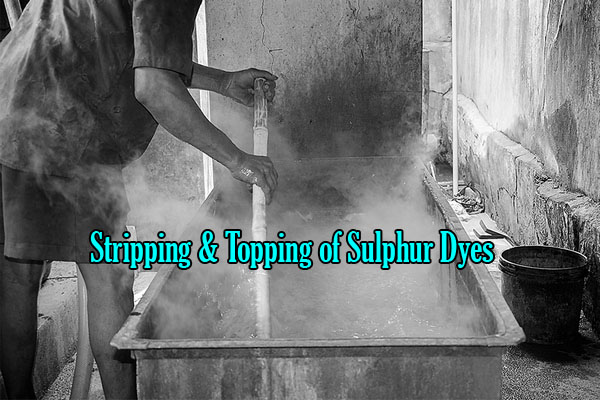Basic Concept of Sulphur Dyes:
Sulphur dyes are insoluble and made soluble by the help of caustic soda and sodium sulphide. Dyeing is done at high temperature with large quantities of salt so that the color penetrates into the fiber. After dyeing, the fabric is oxidized for getting desired shades by exposure to air or by using chemicals. Excess dyes and chemicals are removed by thorough washing. These dyes are fast to light, washing and perspiration and are mostly used for cotton and linen.

Like vat dyes, sulphur dyes are reduced and applied as water‐soluble leuco compounds that need to be kept under alkaline conditions, but sulphur dyes need only sodium sulphide to act as both alkali and reducing agent. Sulphur dyes are usually used for dark colors, such as black, (the most common form of sulphur dye), brown and dark blue; used with indigo to produce denim jeans. In this article, I will discuss stripping and topping of sulphur dyes from the dyed fabric.
Stripping Process of Sulphur Dyes:
Unevenly Dyed shades on cellulosic materials with Sulphur dyes may be corrected by a treatment with a worm solution of Na2S in the presence of Albigen A (polyvinyl pyrolodine)
If this method is found to be in effective then the uneven dyed material may be treated with a solution of a NaOCl or bleaching powder (2-3 gm/Litre of available chlorine).
In some cases bleaching with KMnO4 solution may be effectively carried out. In other cases the dyed material may be treated with worm NaOCl solution in the presence of NaOH.
The uneven dyeing of material causes due to the following reasons:
- The oxidation of dye during dyeing when the material comes in contact with air.
- Presence of gummy material on the fabric.
- Defective Dye.
Stripping of sulphur dye can also be done by treating the dyed goods in a blank bath containing 6 g per liter sodium sulphide at high temperature. A blank dye bath at 90–95°C containing 4.5–9 g per liter sodium hydrosulphite (hydros) and 2–3 ml per liter sequestering agent will strip about 10–20% color while addition of a stripping agent such as polyvinyl pyrrolidine will remove a further 10–20%.
DA-BS800 can strip sulfur dyes also. The dyeing matters can be stripped in bath of sodium hydroxide and sodium hydrosulfite, but can’t in boiling bath of sodium sulfide. The stripping method or application rule of sulfur dyes is same to vat dyes.
Topping of Sulphur Dyes:
Sulphur dyes act as mordents for the basic dyes. The cotton textile materials dyed with Sulphur dyes can be topped with basic dyes for brightening the shades. So, topping of Sulphur dyes is one kind of re dyeing by which required brighter shades are obtained.
For topping of Sulphur dyes, at first dyed materials (dyed with Sulphur dyes) is washed thoroughly to remove the alkali from the fabric. Then the fabric is treated with basic dye in a second dye bath containing acetic acid of alum. In this bath temperature is raised about 60°C to control the exhaustion of basic dye.
To minimize the cost of Aniline Black and Indigo Blue, sulphur color may be topped with Aniline Black and Indigo Blue.
You may also like:
- Problems in Dyeing with Reactive Dyes, Direct Dyes, Sulphur Dyes and Vat Dyes
- What is Basic or Cationic Dye | Properties and Manufacturing of Basic Dyes
- Principal Classes of Synthetic Dyes and Their Characteristics
- Various Classification of Dyes | Different Types of Dyes
